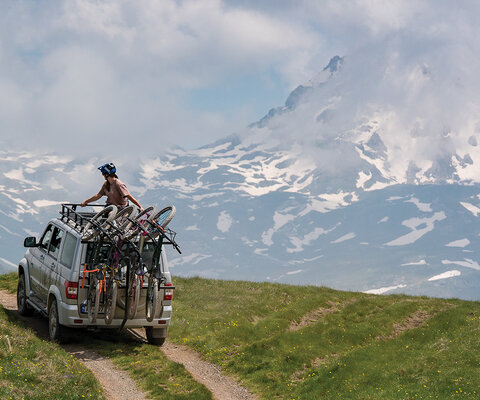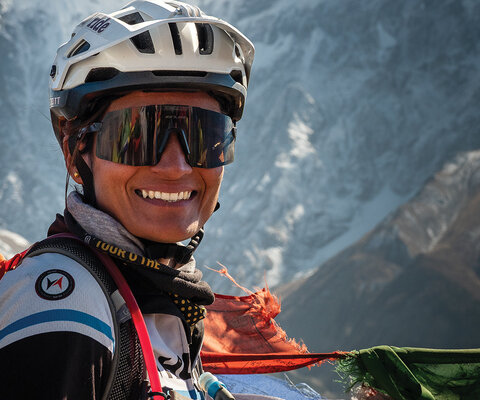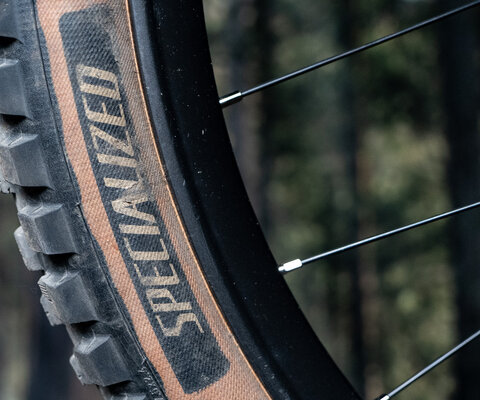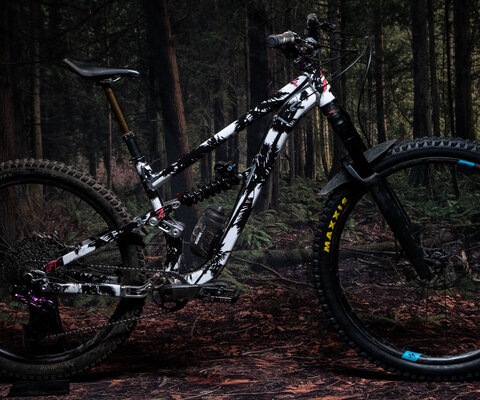
Fine Line Silence and Solitude in the North Cascades
Words and Photos by Riley Seebeck
There are two types of far-flung expeditions: those that are hypothetically possible but guaranteed to be masochistic suffer-fests, and those that are slightly more plausible and still incredibly demanding, but potentially fun.
Fun, in this case, is subjective. Fortunately, as I hung up the phone with Aric Duncan last October, I was confident his proposition fell into the latter category. An ambitious bikepacking adventure was on the table: 75 miles, 26,000 feet of climbing and seven peaks, all in five days. Aric’s proposed route traversed nearly the entire width of Washington’s Cascade Range, from Blewett Pass to Kachess Lake. This swath of land sits between Interstate 90 and Highway 2 and, while it’s undoubtedly remote, it’s impressively littered with trails. A tingle of excitement set in as I scoured the route online. One thing was certain—we were about to enjoy some of Washington’s less traveled singletrack.
Another common attribute of such grandiose missions is the short notice. Aric called me on Thursday and wanted to leave the following Tuesday. But, despite my five-day notice, Aric and his longtime buddy Michael Fischer had dreamt of this ride for most of their lives. Growing up near Ellensburg, Washington, glorious views of the Cascades continually served as visual reminders to them of what lay just beyond their back doors. As mountain bikers, the desire to go a little further and climb a little higher—sometimes just to see what’s over the next ridge—fuels their sense of adventure.
Aric is a freerider who’s at home on anything from slopestyle kickers to Utah ridgelines to backyard Cascadian loamers. Michael, a humble shredder with a moto background, is passionate about technical singletrack and can often be found ripping alongside Aric, equally as hard. Knowing the pair’s willingness to put in long days on the bike, and the incredible region we’d be venturing into, I was committed before Aric even laid out all the logistics.
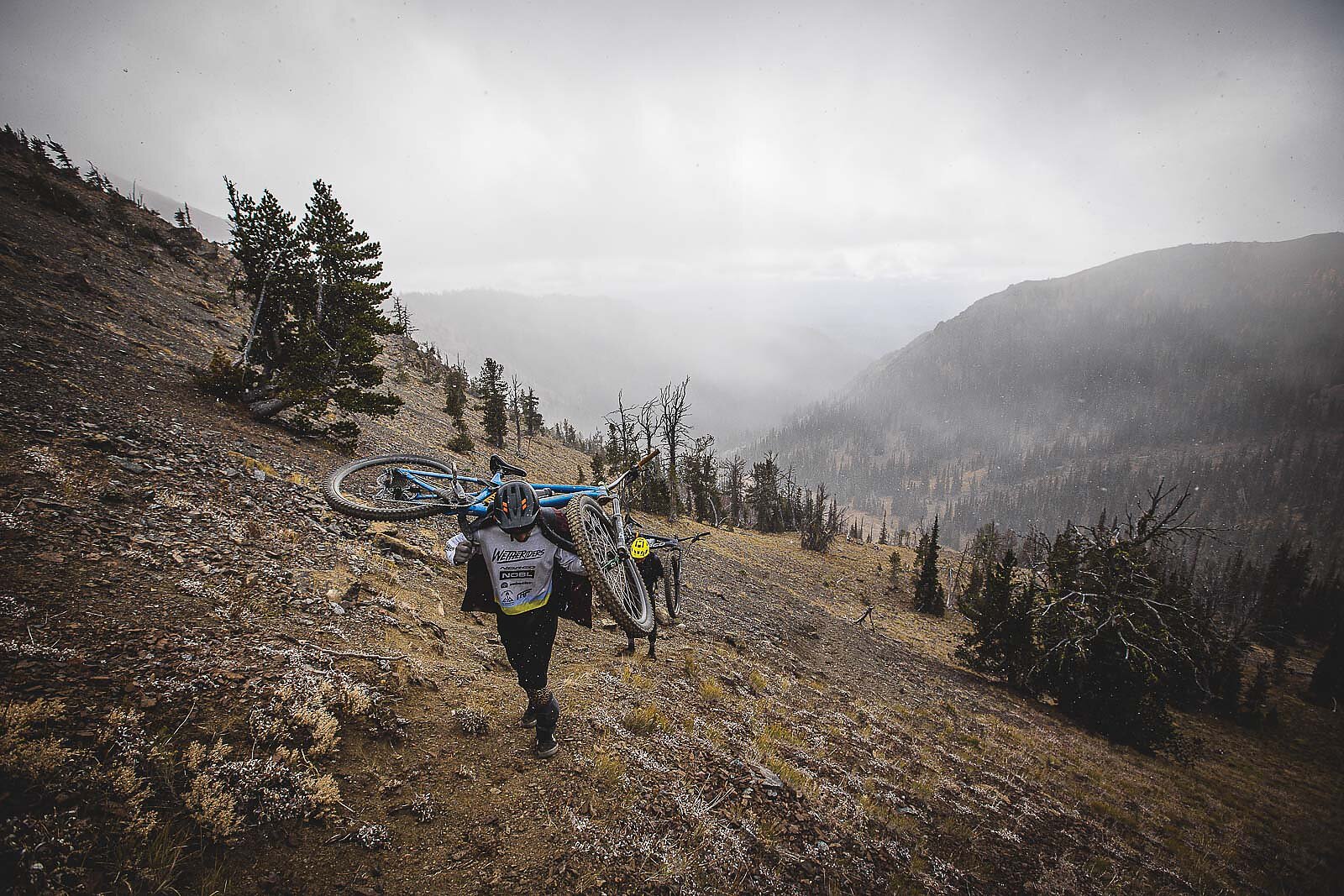
This mission was about venturing deeper into this region than any of us had been before to explore terrain that often seems out of reach. The five-day journey would undoubtedly push our physical limits while immersing us in the simplicity of mountain life. With scree fields in mind, we wanted to find, scout and ride a handful of backcountry freeride lines that Aric and Michael had long been curious about. Scouring Google Earth can only reveal so much. This was a chance to explore the zones in person and put some tires in the dirt. Ambitious? Yes. Possible? Only one way to find out.
We decided to err on the side of comfort, rather than misery, which would let us fully enjoy our bikes unencumbered by heavy bags and overnight essentials. The route traverses the southern end of the Okanogan-Wenatchee National Forest, with many trails funneling into areas accessible by forest roads. So, at the end of each long day, we’d be met with real meals and cold beers delivered by friends and family we recruited to shuttle the truck to that day’s destination. We brought water filters so we could travel light and refill our bottles from the endless supply of crisp, cold mountain creeks. Our packs were so thin it was laughable in comparison to other bikepacking trips any of us had done before. While this was certainly bike glamping at its finest, the days were anything but easy.
We departed Ellensburg with a crisp morning sun, its energy bringing warmth to the chilly October air. The day’s route was a conglomeration of old moto trails, quite often loose and chunky. In no hurry, we ambled at an easy pace, stopping to explore, take in the views, gawk at avalanche paths and re-ride a few fun sections of trail. That first day was meant to boost us up to our cruising elevation, where we would undulate up and down the mountains, through the valleys and—ideally—atop the peaks. Rocky alpine hardpack would turn into soft, pine needle-covered forest singletrack, and then back again.
Starting our mission with sights set on Miller Peak, we’d knowingly jumped into the deep end, but that got the most difficult part of the trip out of the way immediately. An old, winding, exposed mining road crept up and up and up. The rocky terrain slid beneath our feet as we pushed the last bit toward the ridgeline. The view from the top revealed craggy peaks in every direction, all looking as though they were trying to touch the sky. Miller Peak felt so close and so far away at the same time.
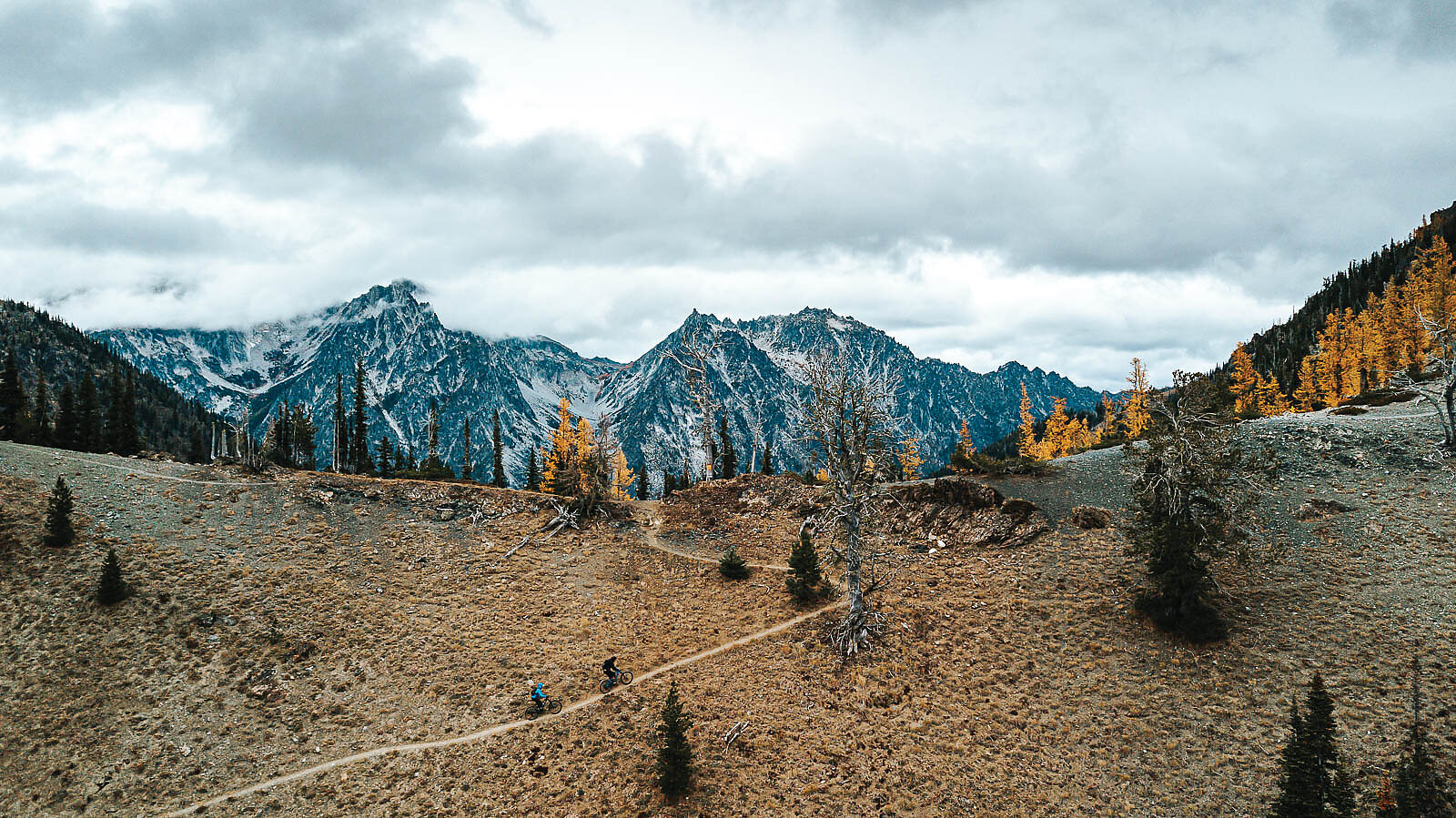
Within a few minutes of dropping in, we were immersed in the mossy forest. The fall colors looked like a Jackson Pollock painting of greens, reds and yellows as we ripped through the woods. The quality of the trail was similarly fantastic. This style of trail is a little different than the trails we’re normally used to with long, straight sections and vast, wide corners that let you carry Mach 10 speed all the way through. The uphill moto trail translated perfectly to downhill mountain biking. The whole descent felt like untamed wilderness, where the complete unknown awaited around each corner.
Once in the valley, intermittent ups and downs along the trail gave us a feel for what was coming. We’d briefly ascend through alpine zones full of fall foliage before a short, sandy singletrack descent, then back up a stubborn climb littered with shale. Rounding a high-speed corner through an open meadow, we pulled up on a view of Mount Rainier that was unlike anything I’d ever seen. We all slammed on our brakes to take it in, almost crashing into one another. The golden meadow, illuminated by the afternoon sun, highlighted the snow-capped mountain in the distance. Miller Peak wasn’t far off as we tore our eyes away from Rainier.
Atop Miller, we found ourselves surrounded by a sea of summits once again, with full views of our route. We could see Navajo Peak toward the North, Bean Peak just beyond and our end goal of Kachess Ridge, which looked lightyears away. Time was of little thought as we sat exchanging beef jerky, cookies and stories, with nothing but 2,300 feet of descending to camp. Only once the sun touched the horizon did we return to reality. The alpine soon gave way to a coniferous blur as we sped through the lavishly green forest. Shadows danced in the late-evening light, keeping our eyes guessing and brake fingers on high alert. An hour later we were setting up our tents, awestruck at how good the trails were.
It usually only takes a day in the wild for civil tendencies to fade. The necessity for clean hands is often first to vanish. A layer of dirt and chain grease does little to dissuade grabbing a handful of food. Next was any care about our clothes, as they became covered in sweat stains and embedded with dust. That first night’s sleep seemed to erase mileage and vertical feet from our brains, a good thing for what was to come.
Day two was to be without our support truck, so that morning we packed up the necessary overnight gear and set off with heavy packs and zealous ambition for the long traverse head. The trail to Navajo Pass began with a meandering climb that offered plenty of opportunity for forest bathing. After paralleling the waters of Stafford Creek, we switch-backed up the hillside through spans of towering cedar. The 3,200-foot ascent is popular with hikers and the trickily spaced-apart rocks kept us entertained as the tawny alpine soil crunched beneath our tires. We wandered through meadows with massive igneous rock sculptures shaped by glaciers some 2 million years ago and past Western red cedars that looked like they could have been 500 years old.
VIEWS OF THE MAJESTIC STUART RANGE ROSE IN TO VIEW, ALONG WITH A COLD GUST OF ALPINE WIND TO OUR FACES, A REMINDER OF MOTHER NATURE’S POWER AND THE RUGGEDNESS OF THIS TERRAIN.
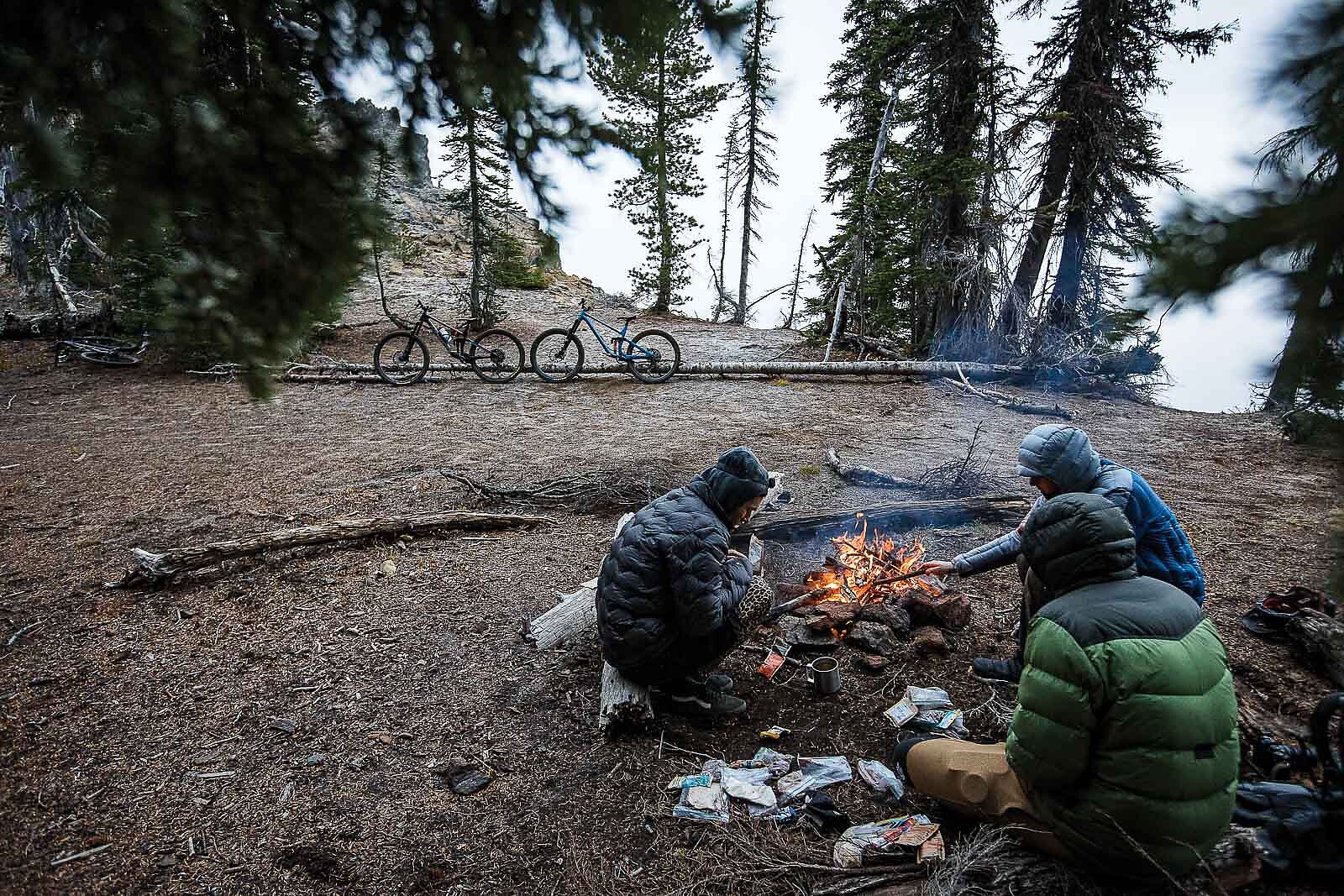
Cresting Navajo Pass, views of the majestic Stuart Range rose into view, along with a cold gust of alpine wind to our faces, a reminder of Mother Nature’s power and the ruggedness of this terrain. In the foreground, however, was a bright orange “Wilderness Boundary” sign. We were at our limit and in awe once again. From our hard-earned vantage point, it was apparent Bean Peak would be difficult too, considering how long it took us to make it up Navajo. We decided to keep pushing along the ridge in search of a camp for the night.
Conditions change fast in the alpine. One moment the clouds can be off in the distance, seemingly innocuous, the next, snarling down from directly overhead, dark, angry and cackling like Zeus himself. As we pressed on, the light grew dynamic, the temperature started to drop and flakes of snow began falling from the darkened sky. We were all getting a bit antsy not being able to find a decent campsite on the side of the jagged, rocky slope. After what seemed like an eternity, we spotted a wooded ridgeline that would surely offer protection from the elements. Relieved and finally taking the time to look back, we saw Navajo Pass basking in the evening light, like a beacon reminding us of our efforts.
In the distance the clouds began to break, offering up an incredible view of the surrounding mountains steeped in dancing rays of evening sun. It felt as if we were being rewarded for the hard work by viewing a light show from the heavens, and we were the only audience. The sky turned fluorescent pink and everything else followed—the ground, the tents, us, our bikes. Everything was a magenta hue, as if we were within the clouds as they lit up with sunset pastels. It was the wildest sunset I’d ever seen, and so beautiful to witness I almost forgot to photograph it all.
“Riley! Dude! The light is insane, are you going to shoot?” Michael said, his words snapping me back to reality as I stood on the cliff edge, camera by my side, jaw dropped in amazement.
Picking up the camera again, I was in every light connoisseur’s paradise. Later, as we crawled into our sleeping bags, the day’s hard work was evident by our sore muscles and stinky socks. That night we fell asleep in the dirt among the bugs, fully content and elated with our good fortune.
The following day we had time to detour to a small scree slope that Aric had previously scouted.
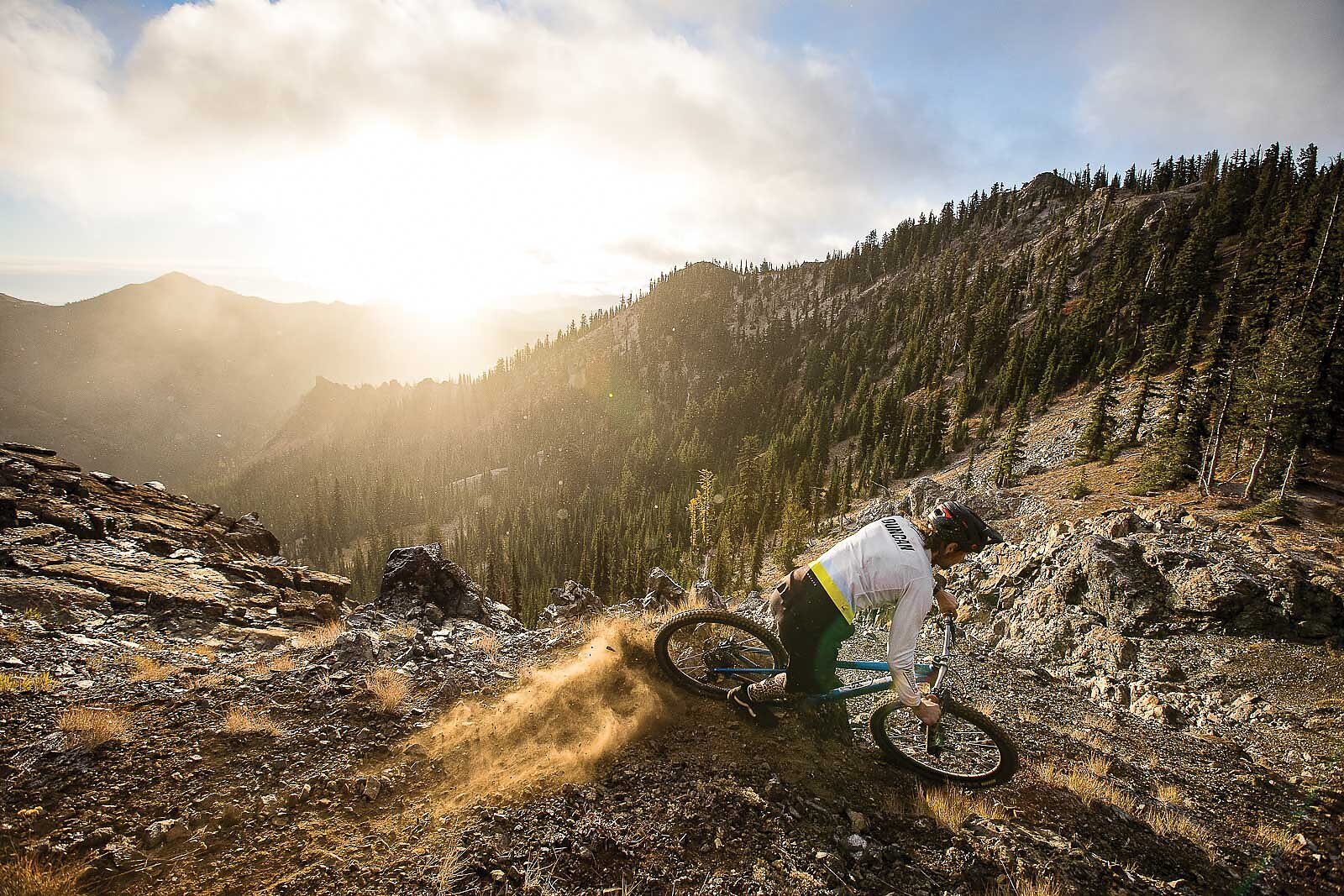
With our bikes on our shoulders, we scrambled a thousand feet up the hillside, eyeing numerous lines down as snow flurries fell. It was quite a mission for a relatively small return, especially considering Aric’s original hopes. By this point of the trip, it was apparent that exploring far off the trail was too costly in time and energy. Weighing risk versus reward, the boys felt confident and dropped in toward the basin floor.
The rattle of loose shale echoed throughout the valley as they locked their back brakes, carving wide, surfy turns and leaving small trenches snaking down the mountainside. Even though the line was rather minimal, it tapped into the spirit of freeride. Our hopes of finding and riding new descents deep in our Cascadian backyard had been realized, if only as a literal scratch on the surface. Hollers of excitement vibrated off the surrounding craggy peaks as the boys came to a stop where rocks met trail. We took one last look up at our descent as the clouds began to cast ominous shadows and the remaining sunlight lit up the fall colors. These mountains were special, and we had them all to ourselves.
The days went by in a beautiful blur of fall colors, fresh alpine air, mind-bending mountain vistas and high-quality laughs. We all savored the last morning, listening to the sizzle of the cast-iron pan and watching steam rise from our coffee cups. We could feel the cold on our faces as winter slowly crept into the Cascades. The dark, frosty morning gave way as the sun breached the horizon to warm our souls. We were one long day away from the end of our trip, but there was plenty to look forward to. As far as singletrack went, the best was saved for last: Kachess Ridge.
Few things kill a coffee buzz like an early morning fire road grind. Our only focus throughout the 2,400-foot climb was the stunningly beautiful ridge-top view ahead of us and the 4,200-foot descent from the top of Kachess Ridge. Starting on No Name Ridge to connect to Kachess Ridge, the notoriously technical and chunky trail exceeded expectations. Side-hilling on narrow singletrack with a 1,000-foot drop to our left slowed us down more than we’d imagined. The trail seemed to drag on forever as we approached another stunning view. Thorp Mountain Lookout loomed atop the rugged ridge among large granite boulders overlooking Kachess Lake, and in the distance the spires of Alta, Chikamin and Lemah peaks towered like guardians of the Cascades. The view filled us with a wave of energy, invigorating our exhausted bodies, tricking us to wish for a couple more days in this paradise.
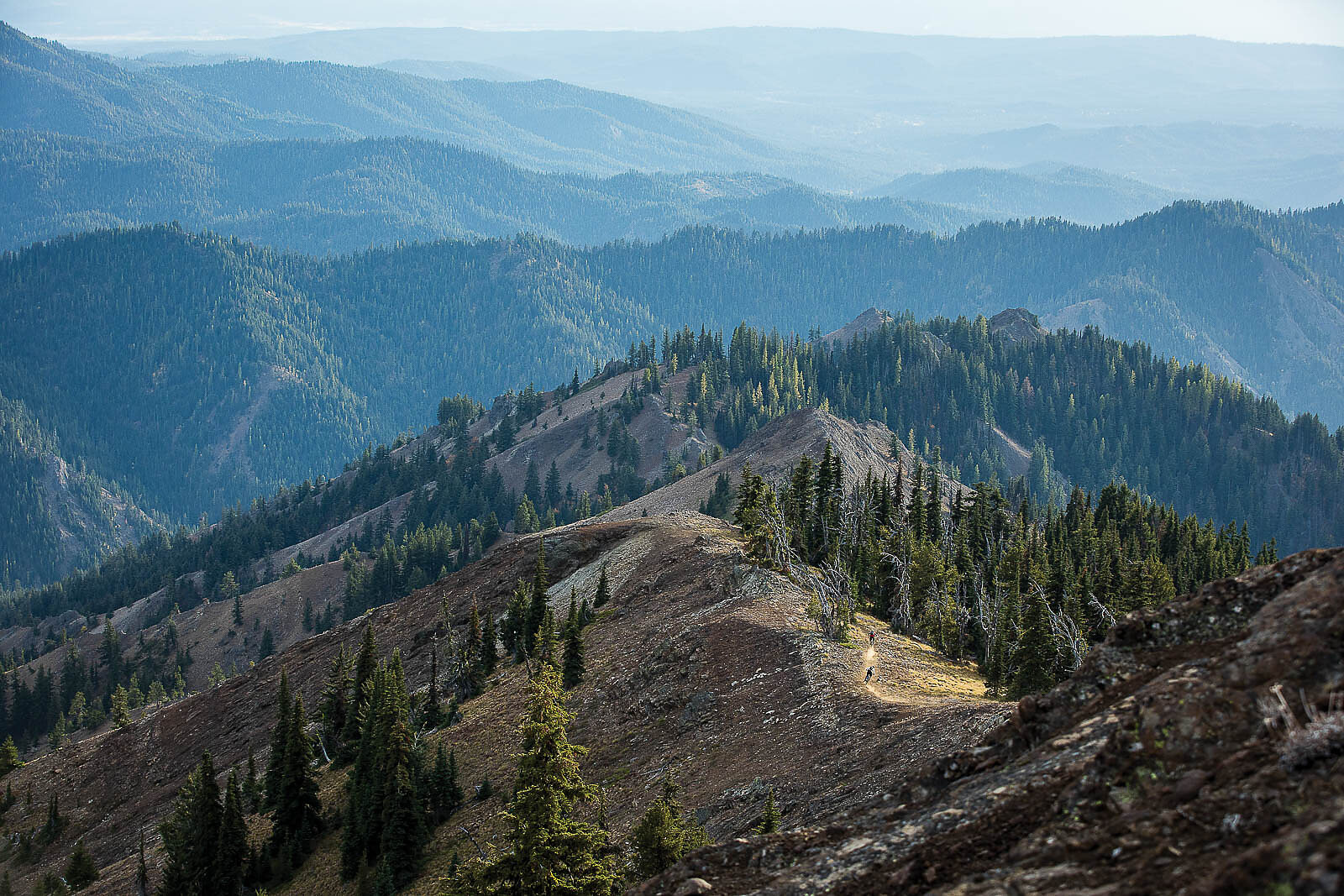
I’d ridden Kachess Ridge many times, but something about this occasion was different. The descent seemed to go on forever. Roots were spaced perfectly to form natural doubles and the wide-open corners barely required any braking. I zoomed through the woods, tripping out on the colors flashing by—the yellows of huckleberry bushes mixed with the reds of alpine blueberry leaves. Weaving through high-speed sections felt like a time warp between microclimates, teleporting us from high alpine meadows to massive forests full of firs to, finally, a desert-like backdrop of rock and sand.
At the bottom, we were greeted by a handful of friends as a rollercoaster of emotions ran through our minds. First, relief that we had made it to the end. Then, sadness because it was over. And, finally, the realization that we were covered in five days’ worth of filth. Instead of disgust, we felt pride.
Our hands had turned a new shade of dark gray, our clothes became inexplicably crunchy and everything smelled like a campfire. Smears of bleached flour evidenced the semi-frozen breakfast burritos we prematurely dug into out of hangry desperation. Mike’s birthday lasagna, homemade by his mom, lived on in tomato sauce stains. Our bloodied shins and greasy hair gave us connection to the wilderness and reminded us of every overgrown trail, each hard-earned sweaty ascent and all the dust-spewing skidder corners of the trip. Like a badge of honor, our layers of grime signified ambition, adventure and one hell of a good time.
